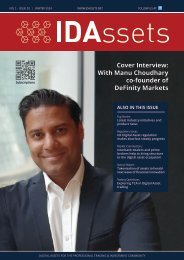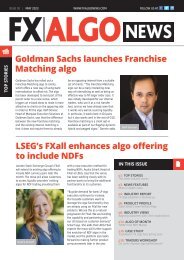e-Forex July 22
Create successful ePaper yourself
Turn your PDF publications into a flip-book with our unique Google optimized e-Paper software.
Bringing more transparency and efficiency to the FX Liquidity Management process<br />
TRADING OPERATIONS<br />
“Relationships really do matter. They should be based on<br />
trust because you want liquidity partners not providers. But<br />
the technology allows for trust with verification.”<br />
John Stead<br />
automatically and look for and notify<br />
the bank of any interesting correlations<br />
and patterns automatically.<br />
The FX Global Code has also had<br />
an impact in encouraging more<br />
transparency and better behaviour.<br />
And finally, there is more awareness<br />
and sophistication in terms of the link<br />
between behaviour and the causes of<br />
liquidity issues.”<br />
In essence, market participants care<br />
more about liquidity management<br />
than ever before and there are more<br />
tools available to help them do<br />
something about it.<br />
An important development on the<br />
technology side has been the use of<br />
artificial intelligence and machine<br />
learning to produce predictive<br />
analytics, says Stead. For liquidity<br />
providers, this is helping them to<br />
identify trading patterns amongst<br />
their clients, to anticipate future flow<br />
and segment their clients accordingly.<br />
“Segmentation has become more<br />
and more important as LPs seek to<br />
optimise their relationships with clients<br />
and to understand their underlying<br />
trading patterns. There will always be<br />
clients that are sharper than others,<br />
but now it is easier to spot them and<br />
LPs care more about it now. If you<br />
combine smartTrade AI Analytics and<br />
our AlgoBox module then you can<br />
automatically spot certain behaviour<br />
patterns and then automatically assign<br />
clients to appropriate pricing and<br />
hedging groups reflecting their impact<br />
and market behaviour.”<br />
The question is the level of automation<br />
that firms are willing to use, says<br />
Stead. For example, to what extent can<br />
automation truly support the trading<br />
and sales team to add more value,<br />
automation for automation’s sake<br />
is not an efficient goal. There is also<br />
more regulatory scrutiny on the use<br />
of artificial intelligence and an onus<br />
on firms to explain how algorithms<br />
have made certain decisions – a<br />
development that is still in its infancy.<br />
But has the use of more advanced<br />
technology and third-party liquidity<br />
managers actually changed the<br />
behaviour of either liquidity providers<br />
and liquidity takers? According to<br />
Stead, there have been changes on<br />
both sides of the liquidity process.<br />
“When it comes to liquidity takers and<br />
the assembly of a panel of liquidity<br />
providers, it was previously thought<br />
that the more liquidity providers, the<br />
better. Now people realise that less can<br />
be more and are moving beyond that<br />
stance,” says Stead.<br />
“The pandemic and the resultant<br />
market volatility of the last two years<br />
have also played a role in this change.<br />
It is during times of crisis that you<br />
find out who your real friends are.<br />
And those LPs that continued to<br />
price during the height of the market<br />
volatility, have been retained and now<br />
form the bedrock of firms’ LP panels.<br />
Then you may have another group of<br />
LPs that will get switched in and out<br />
based on performance,” says Stead.<br />
However, as important as technology<br />
is, there is still a relationship element<br />
to good liquidity management. Stead<br />
says that a greater focus on liquidity<br />
management should encourage<br />
more conversation between liquidity<br />
providers and takers. “Talk to your<br />
clients about how they should behave.<br />
There is an education issue there.<br />
Make sure that your clients are not<br />
sweeping you and that you are using<br />
the proper risk controls in terms of<br />
flow, credit checks, transaction size<br />
and other factors.”<br />
In this space it is during times of crisis that you fi nd out who your real friends are<br />
Technology definitely informs, but<br />
pricing and trading decisions are<br />
often based on a wider context – such<br />
as the other business that may be<br />
done between liquidity providers and<br />
takers. “Relationships really do matter<br />
24 JULY 20<strong>22</strong> e-FOREX

















